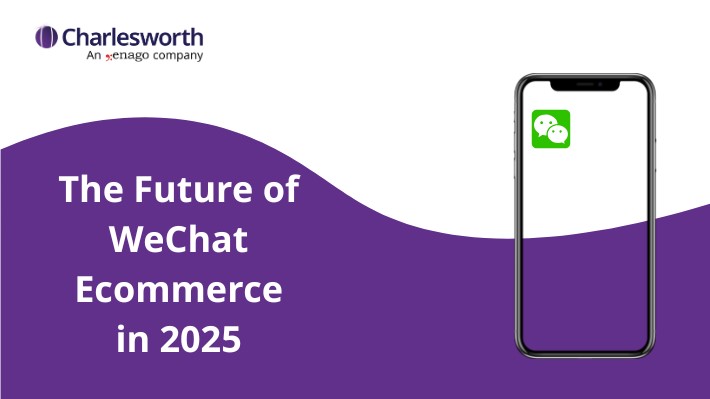The Future of WeChat E-Commerce in 2025: Emerging Trends and Strategic Insights

As 2025 progresses, WeChat e-commerce is evolving, with underlying trends defining how companies do business in China’s largest social and commerce platform. From the growing significance of WeChat Shops to live commerce, private domain strategies, and emerging marketing tools, companies need to keep ahead of these changes to stay competitive.
At Charlesworth, we have collaborated with international brands and institutions to create customized WeChat marketing solutions that improve engagement, establish brand presence, and generate conversions. Based on our experience, here’s how companies can be at the top of the changing WeChat game and realize growth opportunities in China.
WeChat Shops: The Cornerstone of Full-Domain Operations
One of the most important implications of recent WeChat updates is the idea of “full-domain operations”—fully integrating WeChat Shops organically across livestreaming, official accounts, video channels, search, and private domain strategies. In contrast to other e-commerce platforms, WeChat does not incentivize sellers directly with huge subsidies or manipulative traffic influxes. Businesses instead need to build trust and engagement organically within the WeChat ecosystem.
WeChat has segmented participants into three main roles:
1. Merchants – Charged with utilising different channels like livestreams, private traffic (WeChat groups, Moments), and official accounts to drive sales.
2. Sellers (previously influencers) – Now known as WeChat Shop Sellers, which signals WeChat’s concerted effort towards building its e-commerce ecosystem.
3. Service Providers – Businesses providing tools and services to enable merchants to scale their WeChat business, especially in sectors like SaaS, automation, and data analytics.
Using WeChat’s Gift-Giving Feature to Acquire Customers
Gift-based marketing is one of the most impressive strategies picking up pace in 2025. Sending WeChat-based gifts directly to contacts has been an effective means of increasing reach and acquiring new customers.
How It Works:
1. Offline Retail Physical Gift Cards – Offline stores can design QR-code-based gift cards, enabling customers to buy or send gifts online while driving new foot traffic to their WeChat Shop.
2. Gift Cards in Product Packaging – Having a gift QR code within product shipments motivates the recipient to interact with the brand, perhaps buying or gifting the same product to a different person.
3. Hidden Coupons for Special Livestream Promotions – Companies can design exclusive coupons that will only be reachable through special groups or limited livestream sessions.
For instance, a luxury tea company effectively promoted a ¥150 hidden coupon, which was reachable only through an exclusive WeChat group and exchangeable during a two-hour livestream session. This approach noticeably enhanced livestream retention, deepened engagement, and enhanced conversions.
WeChat vs. Other E-Commerce Sites: A Different Playing Field
Compared to sites such as Taobao, Douyin (TikTok China), and JD.com, which are built around algorithm-based discovery and paid traffic, WeChat is relationship-based commerce. Companies need to pursue a long-term engagement model instead of looking for quick, short-term spikes in sales.
Here’s why WeChat e-commerce is different:
- No Platform-Driven Spikes: WeChat does not artificially inflate products or merchants, so success depends solely on business strategy.
- High Entry Barriers: In contrast to other platforms, which provide ease of seller onboarding, WeChat has strict merchant standards for quality control purposes.
- Private Traffic & Community Building: WeChat commerce succeeds because it leverages private domain traffic—groups, personal accounts, and Moments—used to build loyal customer relationships.
That implies that while WeChat is unlikely to yield overnight success, it provides long-term sustainability for those brands willing to invest in audience-building.
Maximising Sales Potential with WeChat Shops
WeChat Shops offer more than ten various selling methods, categorized into two large types:
1.Self-Operated Sales (Direct Sales)
- Public Traffic Sales – Selling through short videos, livestreams, and official accounts.
- Private Traffic Sales – Creating private customer groups and personal contact for long-term interactions.
2.Distributed Sales (Affiliate & Reseller Sales)
- Public Affiliate Sales – Partnering with WeChat Video Channel influencers for increased brand exposure.
- Affiliate Networks & Referral Programs – Participating in massive partnerships for cross-selling initiatives.
- Private Domain Reseller Sales – Using WeChat’s integrated referral and gifting capabilities to stimulate viral customer activity.
For one of our university clients, Charlesworth developed a multi-channel WeChat campaign for student recruitment campaigns. This delivered a dramatic boost in WeChat engagement and enquiries, illustrating the effectiveness of WeChat Shops and targeted marketing in delivering measurable business growth.
The Role of Video Channels in WeChat E-Commerce
Although WeChat has set WeChat Shops as a key growth driver, WeChat Video Channels are still a valuable resource for e-commerce companies.
Brands that produce genuine, informative, and engaging short-form content are experiencing tremendous success. For instance, an organic food brand we collaborated with used WeChat short videos to highlight their farm-to-table process. This resulted in a 200% boost in brand awareness and a significant increase in direct-to-consumer sales.
WeChat Video Success Tips:
1. Honor the intelligence of the audience – Offer informative, interesting, and valuable content.
2. Make every second count – Remove fluff and deliver actionable insights quickly.
3. Use video to nurture private domain traffic – Encourage viewers to join WeChat groups for continued engagement and offers.
Key Takeaways: The Future of WeChat E-Commerce in 2025
1. WeChat Shops Are Here to Stay – Success requires a deep understanding of private traffic, community-building, and personalised engagement.
2.Gift-Giving & Concealed Coupons Will Fuel Growth – Utilizing these tools will assist companies in attracting new customers and driving sales conversions.
3.Video Content is Not up for Debate – Companies need to include short-form video and livestreaming as a way of staying competitive within WeChat’s changing e-commerce environment.
4.Private Traffic is the True Game-Changer – Brands should rather cultivate long-term customer relationships than using platform-driven sales increases.
Most companies have already succeeded in WeChat e-commerce, although it may not be adopting the classic explosive-growth model like on Taobao or Douyin. In 2025, WeChat e-commerce is not going to be making the biggest splash, but beneath the surface, it is churning with potential.
At Charlesworth, we have assisted brands in successfully navigating the intricacies of WeChat marketing, positioning them to be successful in China’s competitive digital marketplace.
With WeChat Shops, mini-program solutions, and sophisticated marketing analytics, we enable brands to engage and convert target audiences successfully. If your company is interested in growing its footprint in China, it’s time to access WeChat’s rapidly developing ecosystem.


